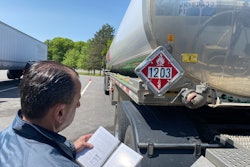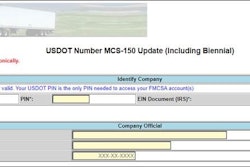Toward the end of last summer, the Federal Motor Carrier Safety Administration released an advance notice of proposed rulemaking (ANPRM) to gather feedback on potential changes to its carrier safety rating system, dubbed its “safety fitness determination” rule.
In January, the agency issued a notice to alert stakeholders that it may consider a handful of reports and studies in developing a proposed or final rule. The notice of data availability (NODA) linked to six reports/studies that FMCSA said it “may consider in responding to the public comments on the issues raised and questions posed" in the advance notice.
All six reports/studies are available in the docket report here. Four of the six are related to the impact of in-cab technology on safety in trucking, possibly indicating that FMCSA is considering tying in the use of safety technologies to safety fitness determinations. A fifth report looks at the impact of federal carrier compliance reviews in reducing crashes. The final report is the National Highway Traffic Safety Administration’s Fatality Analysis Reporting System (FARS) and Crash Report Sampling System (CRSS) coding and validation manual released in 2023.

Only five comments were filed on the NODA, and one of those was withdrawn. There was some support for a close look at all the data, detailed below, yet the Owner-Operator Independent Drivers Association reflected other groups' commentary that the information in the reports and studies “should not be relied upon by the agency in developing a proposed or final rule. We believe the studies contain various flaws that limit their findings."
The association worried that the reports might be "used as a basis to incorporate the adoption and use of safety technologies" in any new SFD methodology, and urged strongly against that in particular.
One study, a close look at in-cab video-monitoring systems published in 2017, showed that the participating drivers experienced the greatest reduction in “risky driving behaviors” when driver coaching was combined with instant driver feedback from in-cab technology. OOIDA noted, however, that the study did not describe very well what “risky driving” was, “neither was it correlated with actual crashes.”
[Related: FMCSA making a run at revamp to carrier safety rating system]
A nearly two-decade-old study (published in 2008) gauged the “impact of federal compliance reviews," largely on-site audits at the time of publication, on crash reduction. It concluded the audit program “has an instant and long-lasting positive impact on reviewed trucking companies in reducing truck crashes. The positive impact can be observed in reviewed companies of all kinds, large or small, for-hire or private, unsatisfactory or satisfactory in safety rating.”
OOIDA noted several limitations in the study, however, including that the companies selected for compliance reviews “may not be a representative sample of the general trucking population and could possibly have a higher risk of crashes than the general population.” Additionally, OOIDA said data used in the study “was collected more than 20 years ago,” when the Federal Highway Administration was the governing agency over commercial motor vehicle enforcement.
“The change in federal agency jurisdiction alone," OOIDA contended, "makes this study and its findings irrelevant as it would be difficult to compare with the system in place today under FMCSA.”
OOIDA also called out limitations of an examination of collision-warning and automatic emergency braking systems (AEBs) that was also included in the agency's notice, with a finding that "front crash prevention systems seem to be effective in preventing rear-end strikes." Collision warning with AEB included was judged "somewhat more effective" than was warning-tech alone.
The relevance of the findings are “negligible at best” for commercial trucks, OOIDA said, as the study population consisted mostly of non-commercial passenger cars and the sample size analyzed was small. "CMVs are larger and heavier, possess different braking capabilities, and face varied challenges related to stopping distances and maneuverability.”
[Related: FMCSA offering 'kinder, gentler' approach to safety scoring? Not if automated inspections go live]
Attorneys Hank Seaton and Mark Andrews also submitted comments on behalf of 11 stakeholders, including CDL Drivers Unlimited, the Air & Expedited Motor Carriers Association, the Auto Haulers Association of America, the Transportation & Logistics Council and others. The groups call FMCSA’s notice “befuddling” in relation to the agency's safety rating program.
“The majority of the documents cited are dated and have no direct relevance to a new SFD or to the agency’s previous notice of a possible reboot of its Safety Measurement System (SMS)," the groups said. They didn't categorically “object to the FMCSA’s consideration of technology to assist carriers in operating more safely and reducing highway fatalities,” yet added “it is an entirely different question, though, whether unproven AI can be developed in sufficient quantity to create an SFD.”
The Trucking Alliance group of large carriers, on the other hand, supported FMCSA for considering the six studies. “Technology should be a part of the way the agency seeks to prevent accidents,” the group said. “In fact, the Trucking Alliance supports the study of all peer-reviewed research regarding truck safety. This process can help develop a safety fitness determination that more closely addresses the need for safety management in the industry.”
A joint filing from the Institute for Safer Trucking (IST), Road Safe America (RSA), and the Safe Operating Speed Alliance (SOSA) said the groups believe the studies identified by FMCSA “hold significant promise for advancing road safety for commercial drivers,” adding that they “urge the FMCSA to give them thorough consideration.”
These groups added that they are “particularly supportive” of studies using “real-time and predictive data sources, which aligns perfectly with the SFD's objective of assessing a carrier's current safety operations.”
The comment period for the NODA closed on Feb. 12.
[Related: FMCSA proposes long-overdue CSA carrier Safety Measurement System revamp]










